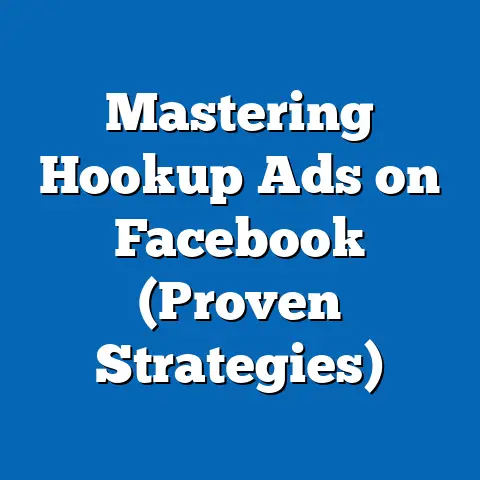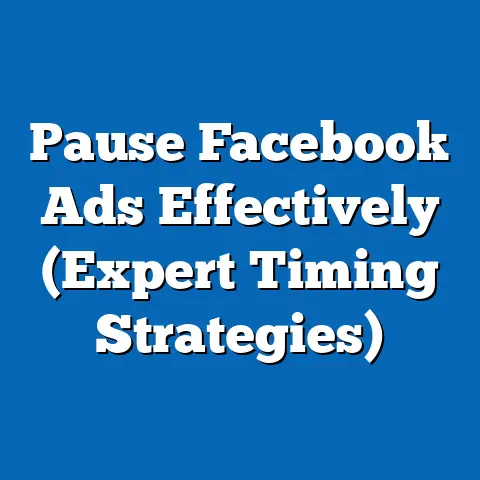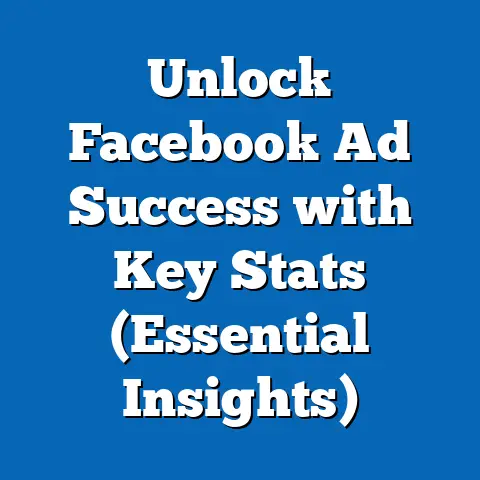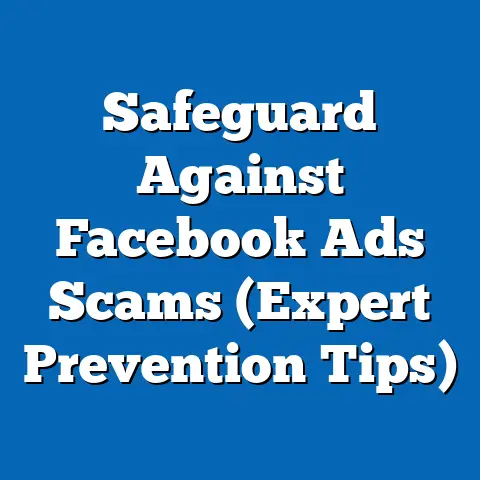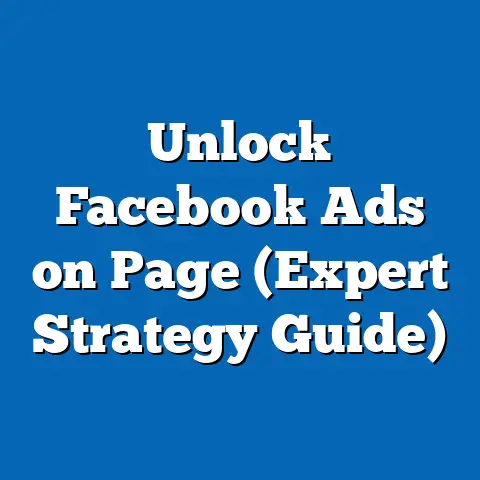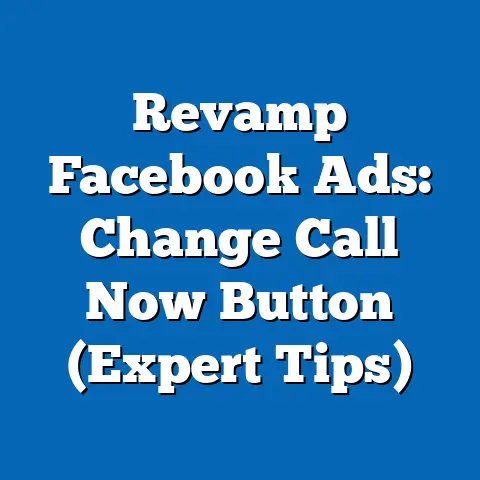Unlocking Blocked Ad CPA on Facebook (Proven Strategies)
Have you ever felt like you’re throwing money into a black hole with Facebook ads? You craft the perfect ad, target your ideal audience, and then… silence. Or worse, the dreaded “disapproved” notification. I know that feeling all too well. I remember when I first started running Facebook ads for my small e-commerce business. I was so excited to get my products in front of a wider audience. But my ads kept getting rejected. It was incredibly frustrating and, frankly, a huge waste of time and money. I spent countless hours trying to figure out what I was doing wrong.
Understanding the Basics of Facebook Ad Policies
Facebook’s advertising policies are the gatekeepers of a user-friendly experience. They exist to maintain a safe and respectful platform for over 2 billion daily active users. Understanding these policies isn’t just a formality; it’s the foundation of successful Facebook advertising. Think of it this way: Facebook wants to ensure its users aren’t bombarded with misleading, offensive, or harmful content. As advertisers, we need to respect that and work within those boundaries.
So, what are some common reasons why ads get blocked? Here’s a quick rundown:
- Misleading or Deceptive Content: Claims that are exaggerated, unsubstantiated, or outright false are a big no-no. For example, promising unrealistic results for a weight loss product or making false guarantees about financial success.
- Inappropriate Targeting: Targeting vulnerable groups or exploiting sensitive topics is strictly prohibited. This includes targeting ads related to health conditions, financial hardship, or personal tragedies.
- Violations of Community Guidelines: Ads that promote violence, hate speech, discrimination, or any form of illegal activity will be immediately rejected.
- Personal Attributes: Ads that directly or indirectly assert or imply things about a person’s race, ethnic origin, religion, beliefs, age, sexual orientation, gender identity, disability, or health condition are also not allowed.
- Sensational Content: Ads that contain shocking, disrespectful, or excessively violent content are often rejected.
Failing to understand and adhere to these policies can lead to ad rejections, account suspensions, and a damaged reputation. For marketers aiming to unlock their blocked CPA, mastering these policies is non-negotiable. It’s about more than just avoiding rejections; it’s about building trust with your audience and creating ads that resonate positively.
Takeaway: Familiarize yourself with Facebook’s advertising policies and community standards. Understanding these guidelines is the first step toward creating compliant and effective ads.
Diagnosing the Blocked Ad Issue
Okay, so your ad got blocked. Don’t panic! The first step is to figure out why. Facebook usually provides a reason for the rejection, but it can sometimes be vague. Here’s a step-by-step guide on how to diagnose the issue:
- Check Your Ad Account Quality Score: In your Ads Manager, navigate to the “Account Quality” section. This will give you an overview of your account’s standing and any potential policy violations.
- Review the Ad Review Process: Facebook’s Ad Review process is designed to ensure all ads comply with their policies. When an ad is submitted, it undergoes automated and sometimes manual review. The Ad Review process offers insights into why your ad was rejected.
- Interpret Facebook’s Feedback: Facebook provides specific reasons for ad rejections. These reasons can range from policy violations to content issues. Understanding this feedback is crucial for making the necessary adjustments.
- Analyze Ad Quality Score: Facebook assigns an Ad Quality Score to each ad based on factors like relevance, engagement, and landing page experience. A low score can indicate underlying issues that need to be addressed.
- Use the Ad Manager Tools: Facebook Ads Manager has tools to help identify issues, such as the Ad Preview tool to see how your ad looks on different placements and the Ad Reporting tool to analyze performance metrics.
Here’s a personal example: I once had an ad for a fitness program rejected because it used a “before and after” photo. While the photos were genuine and the results were real, Facebook’s policy prohibits ads that promote unrealistic body image expectations. I had to reframe the ad with a focus on overall health and wellness rather than just physical transformation.
The key is to be meticulous and persistent. Don’t just assume you know the reason for the rejection. Take the time to thoroughly review the feedback, analyze your ad, and identify the root cause of the issue. This will not only help you unlock the blocked ad but also prevent future rejections.
Takeaway: Use Facebook’s tools and feedback to diagnose why your ad was blocked. Understanding the specific reasons is crucial for making the necessary adjustments.
Proven Strategies to Unlock Blocked Ads
Now for the good stuff – the strategies that will help you get those ads approved and start seeing results! I’ve broken these down into specific areas you can focus on.
Crafting Compliant Ad Copy
Ad copy is where many ads stumble. It’s tempting to use persuasive language and make bold claims, but you need to tread carefully. Here are some techniques for writing ad copy that adheres to Facebook’s policies without compromising on creativity:
- Avoid Exaggerated Claims: Steer clear of phrases like “guaranteed results” or “lose 20 pounds in a week.” Instead, focus on the benefits of your product or service and use realistic language.
- Be Transparent and Honest: Provide accurate information about your product or service. Don’t make misleading claims or hide important details.
- Use “You” Sparingly: Facebook doesn’t like ads that directly address the user’s personal attributes. Instead of saying “Are you struggling with weight loss?”, try “Looking for ways to improve your overall health?”
- Focus on Education and Value: Create ad copy that educates your audience about your product or service and highlights the value it provides.
- Incorporate Testimonials and Social Proof: Use genuine testimonials and customer reviews to build trust and credibility.
Here’s a before-and-after example:
Before (Rejected): “This miracle cream will erase your wrinkles in just 7 days!”
After (Approved): “Discover a skincare solution that can help reduce the appearance of fine lines and wrinkles. See visible results with consistent use.”
The “After” version is compliant because it avoids exaggerated claims, focuses on visible results, and uses language that doesn’t make unrealistic promises.
Optimizing Visual Content
Visuals are the heart of your Facebook ad. They grab attention and convey your message quickly. But they also need to comply with Facebook’s content guidelines.
Targeting the Right Audience
Precise audience targeting can significantly reduce the likelihood of ad rejections. When you target the right audience, your ads are more likely to be relevant and less likely to violate Facebook’s policies.
- Refine Your Demographics: Use Facebook’s detailed targeting options to narrow down your audience based on age, gender, location, education, and other demographics.
- Target Interests and Behaviors: Identify the interests and behaviors that are most relevant to your product or service.
- Use Custom Audiences: Create custom audiences based on your existing customer data or website traffic.
- Leverage Lookalike Audiences: Expand your reach by creating lookalike audiences based on your custom audiences.
- Exclude Irrelevant Audiences: Exclude audiences that are not likely to be interested in your product or service.
For example, if you’re promoting a product for seniors, make sure you’re targeting an age range that aligns with that demographic. Avoid targeting younger audiences who are unlikely to be interested in your product.
Testing and Iterating
A/B testing is your secret weapon for unlocking blocked ads. By testing different elements of your ad, you can identify which ones are causing the rejections and optimize your campaigns accordingly.
- Test Different Ad Copy: Experiment with different headlines, descriptions, and calls to action to see what resonates best with your audience while remaining compliant.
- Test Different Visuals: Try different images, videos, and ad formats to see which ones perform best.
- Test Different Targeting Options: Experiment with different demographics, interests, and behaviors to see which audiences are most receptive to your ads.
- Analyze Your Results: Use Facebook’s Ad Reporting tool to analyze your results and identify trends.
- Iterate Based on Your Findings: Make adjustments to your ad copy, visuals, and targeting based on your findings.
I once ran an A/B test on two versions of an ad for a new product. One version used a direct sales approach, while the other focused on education and value. The direct sales version was rejected, while the education-focused version was approved and performed much better.
Building a Positive Ad History
Your ad account’s history matters. Building a positive ad history with Facebook can impact the success of future ads.
- Adhere to Policy Guidelines: Consistently adhere to Facebook’s advertising policies and community standards.
- Engage with Customer Feedback: Respond to customer comments and messages promptly and professionally.
- Maintain a Good Standing: Keep your ad account in good standing by avoiding policy violations and addressing any issues promptly.
- Use Facebook’s Resources: Take advantage of Facebook’s resources, such as the Ad Policy Help Center and the Facebook Business Help Center.
- Be Patient and Persistent: Building a positive ad history takes time and effort. Be patient, persistent, and committed to creating compliant and effective ads.
Takeaway: Implement these strategies to craft compliant ad copy, optimize visual content, target the right audience, test and iterate, and build a positive ad history.
Real-World Case Studies
Let’s look at some real-world examples of businesses that have successfully unlocked their blocked CPA on Facebook.
Case Study 1: The Fitness App
- Challenge: A fitness app struggled to get its ads approved due to the use of “before and after” photos and exaggerated claims about weight loss.
- Strategy: The app reframed its ads to focus on overall health and wellness rather than just physical transformation. They also removed the “before and after” photos and replaced them with images of people enjoying their workouts.
- Results: The app’s ads were approved, and they saw a significant increase in engagement and conversions.
Case Study 2: The Skincare Brand
- Challenge: A skincare brand’s ads were being rejected due to misleading claims about the effectiveness of its products.
- Strategy: The brand revised its ad copy to focus on the ingredients and benefits of its products. They also included testimonials from satisfied customers.
- Results: The brand’s ads were approved, and they saw a significant increase in sales.
Case Study 3: The E-commerce Store
- Challenge: An e-commerce store’s ads were being rejected due to copyright infringement.
- Strategy: The store conducted a thorough audit of its ad creative and removed any images or videos that they did not have the rights to use.
- Results: The store’s ads were approved, and they were able to resume their advertising campaigns.
Key Lessons Learned:
- Compliance is Key: Adhering to Facebook’s advertising policies is essential for unlocking blocked ads.
- Transparency Matters: Being transparent and honest in your ad copy and visuals builds trust with your audience.
- Testing is Crucial: A/B testing different elements of your ad can help you identify which ones are causing the rejections.
Takeaway: Learn from these case studies and apply the lessons learned to your own campaigns.
Conclusion
Navigating Facebook’s advertising policies can feel like a minefield, but it doesn’t have to be. By understanding the basics of these policies, diagnosing the reasons for ad rejections, and implementing the proven strategies outlined in this article, you can unlock your blocked ad CPA and achieve your advertising goals. Remember, compliance is key, transparency matters, and testing is crucial.
I encourage you to take action on the strategies provided and share your experiences or results in the comments below. Together, we can create a community of Facebook advertisers who are equipped with the right knowledge and tools to succeed.
With the right approach, Facebook advertising can be a powerful tool for growing your business, reaching new customers, and achieving your marketing objectives. So, don’t let blocked ads hold you back. Take control of your campaigns, implement these strategies, and watch your CPA soar!

